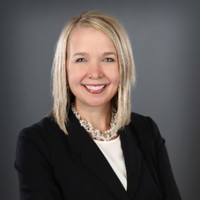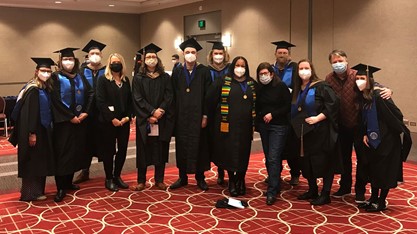Top-Level Takeaways
- Affinity Plus has launched an MBA program in which 17 participants from across the enterprise have graduated, benefitting their careers as well as the credit union’s future.
- The program took two years to build and drew inspiration from similar programs at other credit union.
In December 2021, 17 employees from Affinity Plus Federal Credit Union ($3.6B, St. Paul, MN) became the pioneer graduates of the cooperative’s MBA program at Metropolitan State University.
To launch the higher education initiative, Affinity Plus leaders gleaned insights and inspiration from other credit unions that offer similar opportunities for interested employees. It’s an important benefit that promises to increase workplace satisfaction and foster professional growth.
“We wanted to create a shared experience that would elevate the support employees receive while earning their degree,” says Julie Cosgrove, chief talent officer at Affinity Plus.” We felt we could provide an educational edge to give them a chance to advance their careers, even if it wasn’t a requirement for a job.”

The program drew employees from supporting and member-facing departments, including lending, marketing, operations, ALM and risk, and training. It started in 2019 as an in-person program but went fully virtual two months later because of the pandemic. Still, classes continued once a week for the two-year span of the program.
Here, Cosgrove talks about the insight her cooperative has gleaned from its step into in higher education.
Why did you decide to offer an MBA program for employees?
JC: Affinity Plus believes in creating a work experience that engages, supports, and invests in the development of our employees. The credit union industry is changing and roles are evolving. If we invest in our employees, they will continue to grow into roles we don’t even know about yet but will be developed in the future.
We’re also very committed to diversity, inclusion, and belonging. We’ve moved the educational requirements of a bachelor’s degree or master’s degree from required to preferred. And we recognized the opportunity to develop a program that reduces barriers, including financial, for employees to earn their MBAs.
Where did the idea come from?
JC: In the spring of 2019, I joined our CEO, CFO, and COO at a Callahan & Associates CUFSLP meeting where we learned about an MBA program at Lake Trust Credit Union ($2.5B, Brighton, MI). I was inspired by the impact a program such as this could have on our own employees, and I asked the CEO, David Snodgrass, if he could share more. I’d met Lake Trust’s senior vice president of culture and community engagement, Brandalynn Winchester-Middlebrook, at a previous Callahan roundtable, and she shared insight on how the credit union facilitated its MBA program.

What value does this program offer participants?
JC: We see more employees wanting and needing to elevate their skills to respond to the changing needs of businesses. The MBA was one way in which we could create an opportunity to support skill development.
What value does this program offer the credit union?
JC: Participants grow professionally and personally. They bring more perspectives to their current role and provide feedback to the organization on topics they learn about and are important to Affinity Plus.
For example, the cohort completed a “Diversity and Inclusion” course and shared with the senior team areas they’re proud of and areas where they challenged us to improve. Throughout the program, several participants were promoted and moved into new roles in different areas of the credit union. This development and movement brings more value to the credit union.
4 Tips For Cooperative Collaboration
- Collaborate to both learn and share with others.
- Open your mind to the possibilities of what you can achieve with more minds working together.
- Start with people first. Answer the question: “What impact could we make on people?” If you start and end with how you can make or lose money, you’ll eliminate a lot of opportunities before you even start.
- Ask questions to understand not only what somebody achieved but how they achieved it. Think about challenges they weathered and things they’d do differently.
Can you put an ROI on the program? How much did it cost? How do you measure return?
JC: For the 17 employees, Affinity Plus paid just over $200,000. It’s difficult to put an exact return on this investment, but as we look at the employees and the confidence they built, the knowledge and skills they developed, and the engagement they have within the credit union, the results are incredible.
We also retained 100% of the employees that began the program two years ago and hope we continue to engage and retain them well beyond the conclusion of the program.
How did collaborating with Lake Trust help Affinity Plus launch this program?
JC: Lake Trust’s insight was instrumental in the development of our program. We have a robust tuition reimbursement program in place at Affinity Plus, so this kind of MBA program was not on our radar. Learning about Lake Trust’s experience inspired us to start exploring options of our own.
What does this collaboration say about the credit union industry?
JC:The culture of the credit union industry is rare. There’s a genuine desire to collaborate and support one another freely offering ideas, insights, and opportunities to benefit more than just one credit union, one membership base, or one community.I’m grateful for forums and channels that give us the opportunity to build on ideas from our peers.
David Snodgrass and his leadership team had a great idea and a great result, but they didn’t keep it to themselves. They shared with the goal of impacting and improving other credit unions, resulting in greater strength and results for our industry.This level of openness, sharing, support, and collaboration inspires me to share and learn from others.
What advice do you have for collaborating with other credit unions and making the ideas of others work for you?
CU QUICK FACTS
Affinity Plus FCU
DATA AS OF 09.30.21
HQ: St.Paul,MN
ASSETS: $3.7B
MEMBERS: 230,632
BRANCHES: 28
12-MO SHARE GROWTH:16.2%
12-MO LOAN GROWTH:17.1%
ROA: 1.26%
JC: Put yourself in a position to let it happen. Roundtables, network groups, the CUFSLP group, conferences, and other meetings are great opportunities to ask questions and get genuine answers, and a desire to help and support, back.
Participate in groups to learn from others, gain new insights, and share your own knowledge or perspective. Together, we can build our organization’s and the industry’s strength to benefit more members, employees, and communities.
The word “networking” feels artificial to me; on the other hand, getting involved in groups to connect, learn, collaborate, and share feels authentic and sincere. Oftentimes, it results in greater outcomes than you would have achieved on your own.
This interview has been edited and condensed.